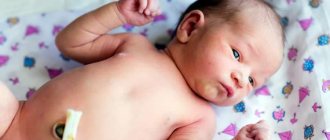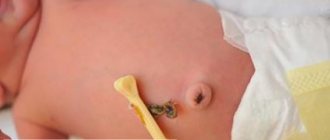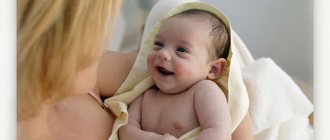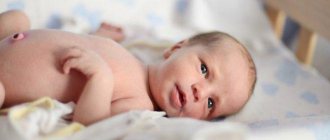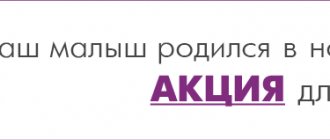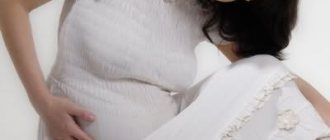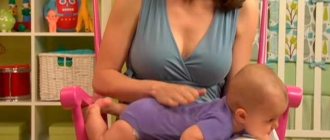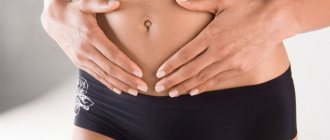Home » Children » How to treat a newborn’s navel with a clothespin?
In the maternity hospital, immediately after birth, neonatologists place a special clothespin on the navel of a newborn. The device stops all processes in the cut umbilical cord.
There are many vessels and other channels through which the child’s metabolic processes with the placenta took place.
When the connecting channel has healed, the clothespin is removed . Until healing occurs in the maternity hospital, doctors treat the umbilical canal with brilliant green. Nurses repeat the treatment every morning.
What parents should pay attention to:
- The color of the tissue around the umbilical ring.
- Smell.
- Contact of clothespin with clothes and diaper.
The clothespin is removed in the maternity hospital, so parents do not need to have special knowledge on this issue.
Important ! Doctors recommend using special diapers with a cutout.
The cutout on the diapers prevents the clothespin from catching on the edges of the diaper, creating discomfort for the child and causing pain.
Why treat the navel of newborns?
As long as the fetus is in the womb, the two organisms are connected by an umbilical cord. Through it, nutrients enter the child’s tissues and harmful substances are removed. After birth, this connection is broken, the child feeds and breathes independently. When the umbilical cord stops pulsating, it is clamped, cut and disinfected. While the baby is in the maternity hospital, all manipulations are performed by medical personnel, but after discharge the mother must take care herself to ensure that the wound does not get infected. The veins and arteries of the umbilical cord are quite large and therefore dangerous.
There are several ways to treat the umbilical cord wound:
- open;
- surgical.
In the first case, the bandage is not applied. Every day the residue is treated with disinfectant solutions, it gradually dries out and subsequently falls off along with the clip-clothespin. This happens on days 5–6, sometimes later, which indicates the presence of infection.
In the second case, the remainder of the umbilical cord is cut off with a surgical instrument, and a pressure bandage is applied to stop the bleeding. It lasts for about 2 hours, then weakens and is removed on the second day. The wound is treated with antibacterial agents until complete healing.
It is important to properly treat a newborn’s navel at home, since at first it gets wet and bleeds a little, crusts form on it, under which a source of infection can form. The baby’s protective functions are not yet sufficiently developed, so bacteria can penetrate the skin and cause a generalized infection of the body.
It is also important to pay attention to the child’s bathing - during the healing of the umbilical wound, the newborn is bathed in boiled water with the addition of medicinal anti-inflammatory herbs, and immediately after the procedure the umbilical cord is treated. Diapers are chosen with a cutout for pinning if the discharge occurred on the 3-4th day and the remainder has not yet fallen off. The clip should not cling to diapers or clothing.
Cochrane
Relevance
Worldwide, infections are the most important cause of death in newborns and are responsible for almost a third of all neonatal (newborn) deaths. Interventions that are accessible, feasible, and effective are needed to reduce neonatal infections and improve neonatal survival. Chlorhexidine, a broad-spectrum antiseptic, is active against common microorganisms that cause perinatal infections. The use of chlorhexidine on the newborn's skin or umbilical cord, or both to prevent infection, is being considered as a possible strategy to improve neonatal survival. In this review, we assessed the effectiveness of chlorhexidine treatment of newborn skin or umbilical cord (umbilical cord care) compared with routine care or no treatment on neonatal survival and infections in newborns born in hospital or at home (in the community).
Characteristics of studies
We searched the medical literature for hospital-based and home-based studies that assessed the incidence of infections and deaths in infants receiving either chlorhexidine or standard practice care after randomization. The searches were carried out until November 2013. Twelve relevant studies were found: seven from hospitals and five from home (community) settings. Four studies provided maternal vaginal lavage with chlorhexidine in addition to skin and umbilical cord care for newborns. The duration of included studies ranged from 6 to 37 months. The number of participants in the included studies ranged from 112 to 29,760. None of the included studies declared any conflicts of interest, and none were funded by pharmaceutical companies.
Main results
Treating the skin or umbilical cord of newborns with chlorhexidine compared with usual care in hospitals
Treatment of the umbilical cord with chlorhexidine compared with dry cord care may not result in any difference in neonatal mortality. However, treating the umbilical cord with chlorhexidine appears to reduce the risk of omphalitis or infection.
Chlorhexidine skin treatment compared with dry cord care may not result in any difference in the incidence of omphalitis or infection (none of the studies in this comparison reported the effect of treatment on the incidence of neonatal deaths).
Treatment of newborn skin or umbilical cord with chlorhexidine compared with usual care at home (in the community)
Chlorhexidine treatment of the umbilical cord, compared with dry cord care, reduces neonatal mortality and the incidence of omphalitis or infection. There was no difference between chlorhexidine skin treatment and usual skin care regarding neonatal mortality (none of the studies in this comparison reported the effect of treatment on the development of omphalitis or infections).
Use of chlorhexidine for maternal vaginal debridement in addition to general body debridement compared with no intervention (sterile saline solution) in hospitals
Treatment of the mother's vagina with chlorhexidine in addition to general whole-body treatment, compared with no treatment, is likely to result in no difference in the incidence of neonatal deaths and infections. Cleaning the mother's vagina in addition to general body cleaning increases the risk of hypothermia.
Chlorhexidine for maternal vaginal debridement in addition to whole body debridement versus no intervention (sterile saline solution) in the community (at home)
Using chlorhexidine for maternal vaginal debridement in addition to general whole-body debridement compared with no intervention may not result in a difference in neonatal mortality. Using chlorhexidine as a maternal vaginal debridement in addition to general whole-body debridement compared with no intervention appears to reduce the risk of neonatal infections (none of the studies included in this comparison reported an effect on the development of omphalitis).
Quality of evidence
Confidence in the effect estimate (quality of evidence) regarding the effect of chlorhexidine on neonatal mortality and omphalitis or infection varied (low, moderate and high). The main reasons for the downgrading of the evidence were poor study performance and lack of sufficient data.
Hygiene of children with an unhealed umbilical wound
The diaper should not come into contact with the umbilical cord
In addition to swimming, you must adhere to several rules:
- Keep your newborn's clothes clean. It is recommended to change it daily or even several times a day if the umbilical wound gets wet. A soiled romper or undershirt can become a source of infection. Clothes are additionally disinfected with an iron.
- It is advisable to buy clothes for your baby only from natural fabrics that are well breathable.
- After bathing, use a clean napkin to remove water around the wound and in it. The hemorrhagic crust is also separated using cotton swabs. In water it softens and is removed without damaging the skin.
- After bathing, you can leave the child naked for a while - any wounds will heal faster in the air.
- The diaper is folded up so that it does not come into contact with the umbilical cord or worn over a long vest. It is important that the wound does not come into contact with wet tissue - bacteria multiply faster in the presence of water.
Since the clamp is in close proximity to the wound, it is recommended to wipe it with alcohol solutions every time the umbilical remnant is manipulated.
How to care for the umbilical wound
It is necessary to follow some rules for caring for the umbilical wound:
You cannot
bathe your baby in a shared bathroom - only in a baby bath with boiled water and potassium permanganate.
You should try to avoid getting too much water on your navel to prevent the wound from getting too wet. It is recommended not to bathe the newborn entirely, but to use damp gauze or a washcloth and wipe the baby's skin.
After bathing procedures, the umbilical wound should be treated with brilliant green or hydrogen peroxide
. If necessary, repeat this procedure 2-3 times a day.
Follow the rule of ventilating your baby's skin
, including the navel. You should avoid tight clothes, and bend the edges of the diapers so that they do not cause friction in the abdominal area.
It is necessary to change the diaper regularly to prevent urine from getting into the umbilical wound.
Not used under any circumstances
care products for treating wounds - creams, gels, oils.
The umbilical wound should be monitored and noticed if the following negative symptoms appear:
- Moisture (pus or blood) constantly collects in the wound,
- She smells bad
- Redness and swelling appeared in the navel area.
Healing time
The healing time of the umbilical cord wound is different for everyone. It depends on the child’s immunity, term and other factors. On average, this period lasts about 4 weeks.
After the umbilical cord has been cut and a stump remains in its place, you need to wait 4 to 7 days for the remainder to fall off and leave a wound. Then another 2 to 3 weeks pass, when all discharge from the navel stops and it heals completely.
If the timing at any stage exceeds the norm by 3 days, then this is considered a non-hazardous phenomenon. If more, there is a deviation. Not all deviations indicate bad developments. If the umbilical cord is very thick, the remainder may fall off after 2 weeks. If there are no signs of infection, you can ignore it. Accordingly, the wound will take longer to heal.
You should be wary if:
- an unpleasant odor appeared;
- the area around became red and swelling appeared;
- there is purulent discharge.
Increased humidity prevents the umbilical cord from drying out and it will take longer to heal. If you do not take care of the stump or wound regularly, they will get wet and the process will be delayed. Caring for the navel of a newborn after the remainder has fallen off should be no less careful, because the scar may regularly bleed or appear ichor. The bleeding does not have to be heavy, but if it happens regularly, you should consult a doctor.
Very rarely, but there are still cases of children being born with the hereditary disease hemophilia, when blood clotting is impaired. In such a situation, it is necessary to monitor the healing process of the umbilical wound until the child is 3 months old.
The heir to the Romanov family, Tsarevich Alexei, almost died due to bleeding from an incompletely healed umbilical wound. Such a long healing already indicated that the child’s health was not all right.
If the baby's skin around the navel turns red and the temperature rises at the same time, you should immediately call an ambulance or take the baby to the hospital yourself. Increased body temperature and lethargy of the newborn may indicate the onset of sepsis.
Daily newborn care
Basic procedures
What is the daily care of a newborn, how to wash the baby and care for the umbilical wound, how to change diapers, take care of nails, feed the baby and walk with him - we will tell you about these basic procedures for caring for a newborn in our article. When the time comes to return home with a newborn from the hospital, every mother begins to worry about how she will care for her child without the help and competent advice of medical personnel.
All mothers, without exception, worry whether they will be able to provide their child with the care necessary for his healthy growth: bathe the baby correctly, cut his nails, treat the umbilical wound.
Therefore, no sooner have mothers crossed the threshold of their home than they have many questions about caring for the child: is it worth washing the baby after each urination, what is better to treat the navel: with brilliant green or calendula tincture?
Today we will try to find answers to the main questions about baby hygiene and talk about the basic procedures for daily baby care.
Morning toilet of a newborn
Like every person, the baby must wash his face in the morning; of course, his mother should help him with this.
After the newborn wakes up, undress him naked and let him lie naked for a while - this is good for the baby’s skin. Then carefully examine the baby, check for redness on the skin or prickly heat. If so, prepare baby cream to lubricate problem areas after washing your baby.
The baby is washed with cotton pads soaked in warm boiled water. Washing the newborn is done from top to bottom. Wipe your baby's eyes from the outer edge to the inner. For hygiene of each eye, it is recommended to take a new cotton pad. Gently wipe the baby's face, the outside of the ears, the skin behind the ears, and the neck with a damp cotton pad.
Listen to the baby's breathing, it should be free. If breathing is difficult, clear your baby's nose. To do this, you can use a special saline solution for children under one year old and an aspirator (a device that helps suck out mucus).
In addition, you can clean the crusts from your nose using two small cotton swabs soaked in baby oil. The flagella must be carefully inserted one by one into each nostril of the child’s nose and scrolled several times. If the baby's nose breathes well, then there is no need to clean it.
Then you need to wipe all the folds of the baby’s skin with a damp cotton pad, replace the child’s dirty diaper with a clean one, wash the baby or use baby wipes to cleanse the skin.
Caring for the umbilical wound
During the newborn period, a special place on the child’s body is the umbilical wound; it requires careful care. As a rule, the umbilical wound is treated once a day; this can be done after bathing, when all the crusts are wet from the water and the mucus is washed away.
How to treat a newborn's navel? There are several methods for treating the umbilical wound, each of them is quite effective:
- caring for the navel with boiled water
- to do this, once a day, moisten a cotton pad with boiled water and thoroughly wipe the umbilical wound so that it becomes clean, then dry the navel for several minutes; - treating the navel with hydrogen peroxide and an antiseptic
(chlorhexidine, baneocin, levomekol, iodine, brilliant green, alcohol-based chlorophyllipt) - to treat the navel, take two cotton swabs, dip one in peroxide, the other in an antiseptic, first treat the navel with the peroxide with which we wash all crusts from the navel, and then with an antiseptic.
Recommendations regarding the choice of one or another method of navel treatment are usually given by nurses in the maternity hospital, as well as by a visiting nurse who will visit your baby during the first month of life.
Important! If you notice that the skin around the umbilical wound is inflamed, be sure to consult a doctor. If you see that the umbilical wound does not heal within a month, it is better to show the child to a doctor. Usually, before 14 days of life, the umbilical remnant disappears and the wound heals.
Washing a newborn
You need to wash your baby under running water after each bowel movement.
It is convenient to wash a newborn like this:
Place your baby with his stomach on your left palm facing you or his back on your forearm with his head facing you. Place the child's lower body under running water. Lather the baby's buttocks and genitals with baby soap (it is better to choose liquid soap for children, it is more convenient to use). Then rinse the soap thoroughly with water and pat the baby’s skin dry with a towel or diaper. If the baby just urinated in the diaper, then you can not wash it, but use wet wipes when changing the diaper. Choose special baby wipes without fragrances or alcohol.
Changing diapers
Most often, mothers use disposable diapers to care for their children. There are several simple rules that are important to follow in this case:
When using them, remember that the child should not be in one disposable diaper for more than 4 hours. You need to put a diaper on a newborn so that the umbilical part is not covered. This is necessary for the fastest healing of the umbilical wound.
It is advisable for the baby to just lie on a diaper without a diaper for several hours a day so that the skin can breathe.
It is also important to ensure that diaper rash does not form on the skin under the diaper. To prevent diaper rash, you need to dress your baby according to the weather, that is, not overheat him, and you can also use a special diaper cream.
If diaper rash has already formed, you need to consult a doctor, he will recommend a remedy for healing it, most likely it will be a cream containing dexpanthenol - an effective healing medicine.
Of course, it is better to prevent diaper rash, as it can be very painful and bother your baby.
Bathing a newborn
All mothers are interested in the question: when can you start bathing your baby after being discharged from the hospital?
“You can bathe your child immediately after discharge, but if you have been vaccinated with BCG, it is better not to bathe your child within a day or two after vaccination, so as not to wet the injection site.”
After the umbilical wound has healed, you can bathe the child in a regular bath in tap water, gradually increasing the bathing time from 5 minutes to 30-40.
Every day while bathing the child, you need to wash his genitals and buttocks, 1-2 times a week you need to wash the entire baby with soap, and also wash the child’s hair with a special baby shampoo.
Important! Always bathe your child with the bathroom door open, this will prevent your child from being so cold after you take him out of the water, since the temperature difference will not be too great.
Each time you lower your baby into the water slowly, starting with his feet. The child's entire body must be supported in the water. If water gets into your baby’s ears or eyes while bathing, it’s not scary, it’s completely natural!
Already from the first days of life, you can begin to lightly harden your child. To do this, before you start bathing your baby, prepare and place a vessel with water in the bathroom, the temperature of which will be 0.5-1 degrees lower than the temperature of the water in the bath. At the end of the bath, pour water from this container onto the child.
After bathing the baby, you need to blot it with a diaper or towel, but do not dry it, as this procedure can damage the delicate baby skin.
You also need to prepare two small cotton wool flagella and gently screw them into the child’s ears so that the cotton absorbs the water that got into the ears during bathing. After the baby's skin has dried, it is advisable to treat the folds with baby oil.
Newborn nail care
It is necessary to take care of your baby’s nails 1-2 times a week, since children’s nails grow very quickly. To cut nails, you need to purchase special scissors with rounded ends. On the toes, nails should be cut straight, and on the hands, the edges should be rounded.
Walking with a child
In the summer, you can go for a walk with your baby the next day after being discharged from the hospital. It is advisable to protect the child from direct sunlight. It is better to go for a walk in the summer either in the morning (before 10 a.m.) or in the evening (after 6 p.m.), at this time it is not so hot.
In winter, it is recommended to start walking 2-3 days after discharge from the hospital. If the temperature outside is below 10 degrees, it is better not to go for a walk with your baby.
The first walk should be very short - 10-15 minutes. Then every day you should walk 10 minutes longer.
When preparing for a walk with their baby, mothers usually doubt whether they have dressed the baby correctly. In order not to make a mistake with clothes, you should always follow a simple rule - the baby should have as much clothes as you have, plus one more layer. This way the baby will be comfortable.
Of course, it is worth checking the child’s condition during a walk. In the summer, it is important not to overheat the baby: if the child turns red, it means that you should take something off him, he is hot.
In winter, there is a high risk of freezing. If the baby is cold, he will have cold hands, feet and nose, in which case an extra blanket will not hurt.
OH. Abzalova, neonatologist
Effective and popular drugs
Previously, midwives and nurses filled wounds with brilliant green, not sparing the drug. Today, this method is considered outdated and is not practiced. Firstly, cases of side effects after using brilliant green have become more frequent. Secondly, a thin film interferes with rapid healing. Thirdly, there is no way to control the condition of the wound, since the skin is green, there is a risk of missing the infection process that has begun. The same goes for methylene blue. To date, several cases of acute toxic poisoning from aniline dyes have been reported. As a result, hemoglobin in the blood, designed to deliver oxygen to tissues, is converted into methemoglobin, which is not able to perform this function, since the iron in this compound is trivalent.
It is also not recommended to use alcohol, especially pure alcohol. It can cause soft tissue burns and cause skin ulcers. If you don’t have disinfectants on hand, as a last resort you can use diluted vodka.
Recommended products:
- Hydrogen peroxide 3%. A good inexpensive remedy that at the same time makes it clear whether the wound has healed completely or not. If you apply the substance to the navel and it hisses, then the wound still requires treatment. If there is no hissing, the procedures can be stopped. The product soaks the crust well and is non-toxic.
- Chlorhexidine is an antiseptic. Before purchasing, you need to know exactly what concentration is suitable for the skin of a newborn. Usually the doctor prescribes 0.05%, and all negative reviews about this drug are associated with the inattention of parents. Before instilling chlorhexidine, it is necessary to pour peroxide into the wound, then blot it dry, although sometimes the drug is used for the initial treatment of the navel.
- Fukortsin is a fairly strong drug that contains phenol, a toxic substance. It is used in cases where the wound does not heal for a long time and constantly gets wet. The doctor selects the concentration and also indicates how often to use the product.
- Baneocin is an antimicrobial drug with an antibiotic. Safe for children of all ages, available in ointments or powder. It is used for normally healing umbilical wounds and for complicated course of the process. Apply after primary treatment.
- Potassium permanganate is the most common means for primary disinfection. A weak solution is made and poured into the navel through gauze. After a while, you need to wipe it dry with a napkin and apply a substance for secondary treatment.
- Chlorophyllipt is an alcoholic infusion of eucalyptus leaves. Suitable for umbilical cord processing due to its antimicrobial properties. Successfully fights staphylococcal and streptococcal infections. After peroxide, apply with a pipette. In most cases, it does not cause allergies or discomfort in the baby. An infusion of 1% concentration will be required.
- Levomekol ointment with antibiotic. It is used to accelerate the healing of the umbilical wound in the absence of complications, as well as in case of redness and signs of infection. Long-term use should be avoided - this causes itching and redness, as in the case of allergies.
If there is no redness, you can get by with peroxide and chlorophyllipt. If healing is delayed, Baneocin or Levomekol will help. Fukortsin is used in extreme cases and only after consultation with a doctor, since it is prescribed to children under 12 years of age with caution.
How to properly treat the navel in newborns
Activities for caring for the navel of newborns are carried out in the morning or evening after bathing. It is more convenient to do everything in the evening, since the baby is getting ready for bed and is less active.
Algorithm of actions when treating the umbilical wound in a newborn:
- Wash your hands with soap.
- Place the baby on a changing table or other flat surface.
- Take a pipette, collect hydrogen peroxide and pour it over the wound. Wait until the hissing stops, then use a cotton swab to carefully remove those crusts that come off easily. Others should not be touched - they may start to bleed. You can use potassium permanganate or chlorhexidine.
- Rinse again with peroxide and wipe dry.
- Dry powders are simply poured into the navel for secondary processing. Ointments can be applied with a cotton swab. Liquid products are dripped with a pipette.
If the clothespin has partially fallen off, it is not recommended to pull it. The area around the clip is treated, at the same time the clothespin itself is watered with peroxide, then dried.
If drugs such as brilliant green, blue, or fucorcin are used, it is better to prevent them from coming into contact with adjacent tissues so that the treatment area is narrowed as much as possible.
When the stump falls off after another bath or during treatment, a few drops of blood may appear. It's not scary. As a last resort, apply a hemostatic sponge.
The navel of newborns is treated 1 – 2 times a day. If redness appears, you can do this 3 times - in the morning, at lunch and in the evening.
The navel of a newborn is festering: how to treat it at home?
Young parents may notice inflammation of the umbilical cavity while bathing their baby. The navel is red and looks unhealthy. There is something sticking out in the navel, but it doesn’t stick out at first. After a few days it increases in size.
This disease is called fungus or granuloma. Proliferation of granulomatous tissue for unknown reasons. A common disease in infants. The treatment is simple.
Doctors cauterize the fungus and recommend that parents take special care to maintain wound hygiene. It is better to stop massage and water treatments for a while.
After removing the granuloma, the navel is treated with brilliant green, peroxide, and washed with clean boiled water or chlorhexidine.
The technique is as follows:
- The child is placed on his back.
- A diaper is placed under the baby.
- Chlorhexidine or peroxide is dripped into the umbilical wound.
- Blot excess liquid with a cotton pad.
- An antibiotic ointment is placed in the navel and a bandage is applied.
This disease causes panic among parents. There is no reason to worry. It is necessary to follow the rules for disinfecting the umbilical ring.
Important ! A protruding part has appeared on the abdomen near the navel - a hernia; you should consult a surgeon for advice.
Hernia is common in babies. The hernia is especially noticeable when crying. As the abdominal muscles strengthen, the hernia may disappear. Otherwise, a sectioning operation is necessary.
Useful video
Share this post
- Related Posts
- What to buy for a newborn baby: list of things
- Reasons why a child walks on his toes
- How to properly sew an envelope for a newborn’s discharge with your own hands?
- What to do with a child on a train, plane and car by year
- Beautiful DIY crafts from vegetables and fruits for kindergarten
- A child has vomiting without fever and diarrhea: causes and first aid
Possible complications
Complications of the umbilical wound are more often observed in weak and premature children. Omphalitis is a weeping navel. With this complication, there are tubercles with purulent or serous contents at the bottom of the wound. Additionally, vitamin therapy is carried out, and ultraviolet irradiation of the abdominal area is also prescribed.
In severe forms of omphalitis, swelling of the peri-umbilical area is observed - the skin turns red and its temperature rises. The vessels become denser and can be felt with your hands. Hospitalization and treatment in a hospital are required. In some particularly dangerous cases, surgery may be necessary.
Umbilical fungus is typical for children with high birth weight. It manifests itself as mushroom-shaped growths. Most often they are cauterized with a lapis pencil; in severe cases, they are operated on and removed.
Umbilical cord hernia is a common occurrence in newborns. On examination, a wide umbilical cord may be observed. If there are no signs of entrapment, apply a bandage to the abdominal cavity. This phenomenon usually goes away on its own up to three years, but it is better to conduct several courses of massage and strengthen the abdominal muscles to reduce the risk of intestinal obstruction.
